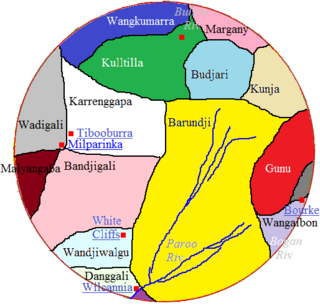
The Gangulu people, also written Kangulu, Kanolu, Kaangooloo and other variations, are an Aboriginal Australian people from the Mount Morgan area in Queensland, Australia.
The Wangan are an indigenous Australia people of the Isaac Region of Central Queensland. There is no linguistic data.

The Baranha or Barna, also known as Barada Barna, are an Australian Aboriginal people of northern Queensland.
The Tulua people were an Aboriginal Australian people of Queensland, in the southern to central region from the coast to the ranges. The Dappil and Tulua people possibly spoke the same language.

The Wadjiga people, also known as Wadja, Maudalgo, Wadjainggo, and other variants, were an Aboriginal Australian people of inland eastern Queensland.
The Wakabunga are an indigenous Australian people of the state of Queensland.

The Karenggapa are an Aboriginal Australian people of New South Wales.
The Wangkumarra are an indigenous people of the state of Queensland, Australia.
The Bidjara people, also spelt Bitjara or Bithara, are an Aboriginal Australian people of south-western Queensland. They spoke a dialect of the Ngura language. They are not to be confused with the Warrego River Pitjara or the Badjiri of the Paroo River, both of whose traditional lands are further to the east of the state.
The Bidjara or Pitjara are an Aboriginal Australian people of eastern Queensland. They are to be distinguished from the Bidjara of southwestern Queensland and the Badjiri of southern Queensland.
The Marrago were an Aboriginal Australian people of the state of the Cape York Peninsula in northern Queensland. They may have been a subgroup of the Mayi-Kutuna.
The Wanamara (Wunumara) were an indigenous Australian people of the state of Queensland.
The Rungarungawa were an indigenous Australian people of the state of Queensland.
The Yilba, also written Ilba and Jilba, are or were an Aboriginal Australian people of the present-day state of Queensland.
The Yangga, also spelt Jangga, were an Aboriginal Australian people of the state of Queensland. They are not to be confused with the Yanga people.
The Yagalingu were an indigenous Australian people of the state of Queensland. Their language may have been a dialect of Bidjara.

The Yambina were an Aboriginal Australian people of the state of Queensland, whose traditional lands lie inland (westwards) some distance from Mackay.
The Yalarnnga, also known as the Jalanga, are an indigenous Australian people of the state of Queensland.
Burrandilla County is a cadastral division of Queensland and a County of the Warrego Land District of south western Queensland.
Palmer County is a cadastral division of Queensland and a County of the Warrego Land District of southwestern Queensland.